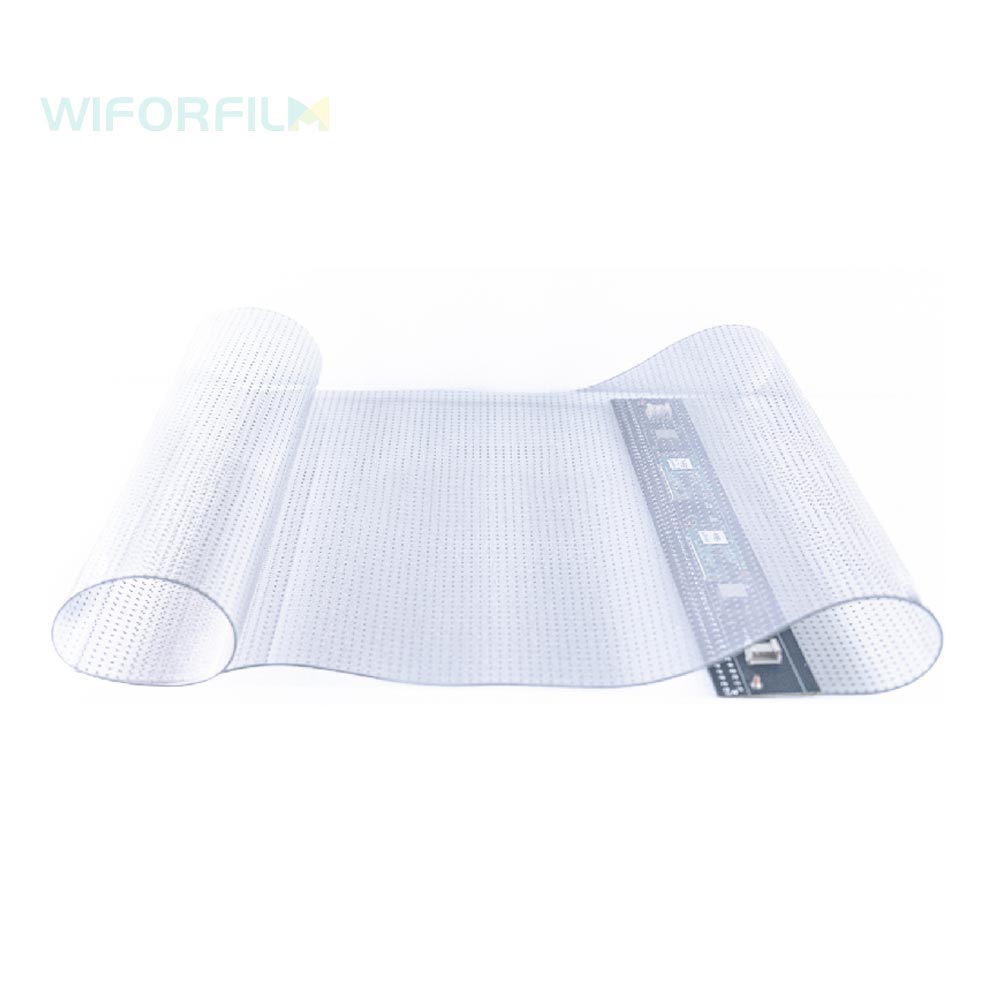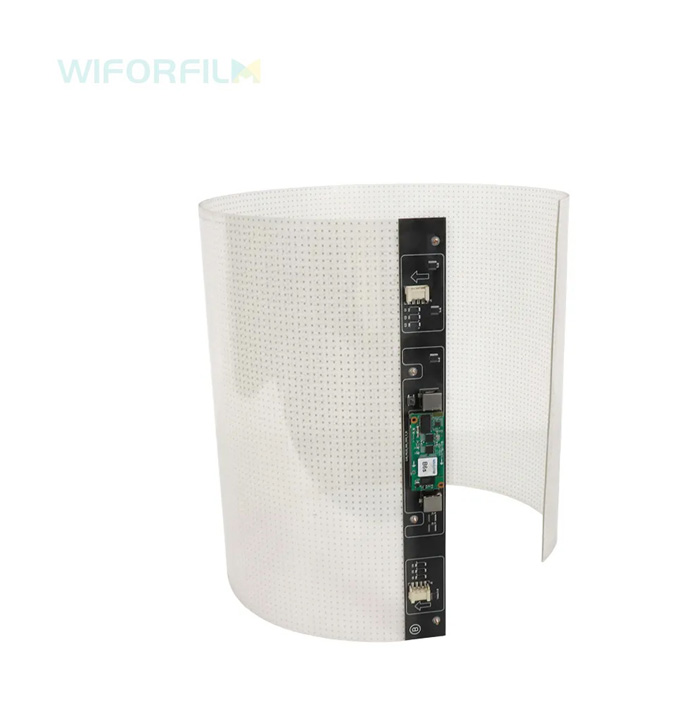LED Film Screen
The LED film screen turn glass window or glass wall surfaces into vibrant, dynamic video displays while maintaining visibility. These innovative solutions can be seamlessly retrofitted onto any glass surface, enabling full-color video playback without obstructing the view inside or outside the building. LED film display with a modular design, they adapt effortlessly to any setting, enhancing functionality and aesthetic appeal.
The LED film screen series represents a groundbreaking display technology that requires no structure, no programming, and no adhesive tape. With a transparency of 90%~95%, it can be effortlessly applied to commercial window glass or transparent acrylic panel without the need for an additional professional team.
Available in various pixel pitches such as 3.91mm, 5mm, 6mm, 6.25mm, 8mm, 10mm, 15mm, and 20mm, this LED film display offers different brightness options to suit various installation locations. (The larger the pixel pitch, the lower the resolution and the higher the transparency.)
The LED film display can be seamlessly spliced together to cover larger areas, and the panels can be custom-cut to the required dimensions based on your needs.
Installation is simple: just use a squeegee to easily apply the LED film screen to the commercial window glass or acrylic panel. Additionally, we provide remote support from our technical team for assistance.
Key Features of LED film display:
- High brightness of 3000-6000 nits, ensuring clear visibility even in daylight.
- 85-95% transparency with hidden wiring.
- Flexible panels that can be bent, cut, and are not restricted by size or shape.
- Can be directly adhered to glass or transparent acrylic panels, making installation extremely simple.
- Optional LED pixel pitch ranging from 3 mm to 20 mm.
- Automatic brightness adjustment for day and night.
- The LED film offers a dedicated app and supports customization of content (Image, text display, animation, and video) playback via computer, tablet, phone, Bluetooth, and Wi-Fi.
-
Supports customization of any size based on various installation environments.
Through the Novastar controller, you can set and control content in real time.
Alternatively, you can choose Novastar controller to upload content via mobile phone, computer, tablet, Bluetooth, or WiFi, supporting the display of images, text, animations, and videos.
Through the cloud, you can also remotely manage video content on LED film screen at different locations and monitor their status.
Novastar controllers are especially advantageous for large transparent LED film projects.

Types of LED film screen

|
| Flexible Transparent Crystal Film |
| Material - PET and transparent adhesive film |
| Panel size - 400mm (w)*1000mm(h)(Can be customized upon request) |
| Pitch options - 5mm, 6mm, 6.25mm, 8mm, 10mm, 15mm, 20mm |
| Brightness - 2000-4000nits |
| Transparency - 85-95% |
| Application environment - indoor and semi-outdoor |
| LED film screen price:The price of LED film screen vary according to different models, ranging from $650 to $2,200 per square meter. |
 |
| Holographic Film |
| Material - Grid-shaped black holographic screen |
| Panel size - 250mm (w)*1000mm(h)(Can be customized) |
| Pitch options - 3.91mm, 6.25mm |
| Brightness - 800-6000nits |
| Transparency - 70-90% |
| Application environment - indoor and semi-outdoor |
| holographic LED screen price:The prices ranging from $1200 to $2,250 per square meter. |
Difference between adhesive LED film screen and normal LED screen
| Item | adhesive LED film screen | Structure Transparent LED screen | Conventional LED Screen |
| Weight | ≤3.5 kg/m² | ≤10 kg/m² | ≤35 kg/m² |
| Screen Thickness | ≤3 mm | ≤10 mm | around 100mm incl power box |
| Powerbox Thickness | 60 mm | 80mm | around 100mm incl power box |
| Transparency Rate | 90% ~ 95% | 60% ~ 90% | 0 |
| Installation Way | Adhesive to glass or transparent acrylic panel (No need frame) | Fixed / Hanging | Fixed |
| External Structure | Not needed | Simple frame | Heavy frame |
| Flexible | Bendable | Customized for a certain angle | Customized for a certain angle |
| PCB | Invisible (Thin film circuit) | Traditional PCB | Traditional PCB |
| Drive Mode | Static drive | Dynamic scanning | Dynamic scanning/Static |
| Heat Dissipation | Natural cooling | Natural cooling | Fan |
| Impact on the original structure | No impact | Medium impact | Big impact |
| Maintenance way | Tear off film from glass | Take off panel | Take off module |
| Pixel pitch | P5,P6, P8, P10, P15, P20 |
|
|
| Resistance to fall, crack, collision and dusk | Yes | No (Yes if with GOB) | No (Yes if with GOB) |
| Waterproof | IP65 for film surface | IP30 / IP65 for some models | IP30 / IP65 |
Specifications Of adhesive LED film screen
| MODEL | P6 | P8 | P10 | P15 | P20 |
| Module size (mm) | 1000*400 | ||||
| LED light | REE1515 | REE2121 | |||
| Pixel composition | R1G1B1 | ||||
| Pixel spacing (mm) | 6.25*6.25 | 8*8 | 10*10 | 15*15 | 20*20 |
| Module pixel | 160*64=10240 | 125*50=6250 | 100*40=4000 | 66*26=1716 | 50*20=1000 |
| Pixel/m2 | 25600 | 16500 | 10000 | 4356 | 2500 |
| Brightness | 2000-3000 cd/m² | 2000-3000 cd/m² | 2000-4000 cd/m² | ||
| Permeability | 90% | 92% | 94% | 95% | |
| Angle of view ° | 160 ° | ||||
| Input voltage | AC110-240V50/ 60Hz | ||||
| Peak power | 600w/㎡ | ||||
| Average power | 200w/㎡ | ||||
| Work environment |
Temperature -20~55°C Humidity 10-90% |
||||
| Weight | 1.3kg | ||||
| Thickness | 2.5mm | ||||
| Drive mode | Static state | ||||
| Control system | Nova/Colorlight | ||||
| Typical value of life | 100000H | ||||
| Grayscale level | 16bit | ||||
| Refresh rate | 3840 Hz | ||||
Specifications Of Holographic Transparent LED Screen
| PIXEL PITCH | P3.91 | P6.25 |
|---|---|---|
| Screen Size (w*h) | 250x1000mm、250x1200mm | |
| Brightness | 4000nits | 5000nits |
| IP Rate | IP30 | |
| Panel Weight | ≤ 5KG/㎡ | |
| Max Power Consumption | 800 W/㎡ | |
The LED film display commonly used in Retail Storefronts,lobbies and meeting rooms,Architectural Displays,Events and Exhibitions, and commercial spaces, they allow high-quality visual displays without obstructing views. The make them ideal for creating dynamic visual effects on glass walls, window, and Special-shaped curved glass surfaces.
Videos of LED film screen











